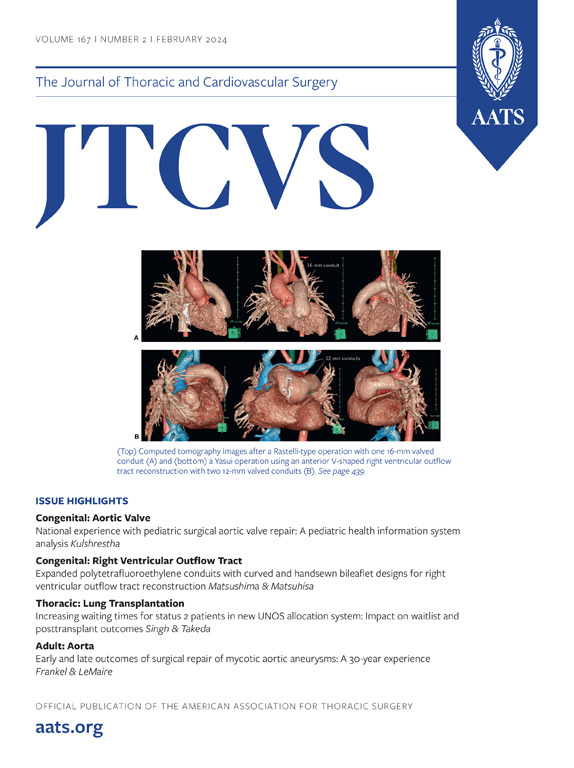Bovine pericardial versus porcine bioprosthetic aortic valves: A nationwide population-based cohort study in Korea
IF 4.9
1区 医学
Q1 CARDIAC & CARDIOVASCULAR SYSTEMS
Journal of Thoracic and Cardiovascular Surgery
Pub Date : 2024-11-01
DOI:10.1016/j.jtcvs.2023.10.060
引用次数: 0
Abstract
Objective
To compare the clinical outcomes of aortic valve replacement (AVR) using bovine pericardial and porcine bioprostheses, utilizing a nationwide administrative claims database.
Methods
Adult patients (age ≥40 years) who underwent bioprosthetic AVR, without other valve replacements, between 2003 and 2018 were identified from the Korean National Health Insurance Service database. The outcomes of interest were all-cause mortality, cardiac mortality, and valve-related events, including the incidence of reoperation, endocarditis, systemic thromboembolism, and major bleeding. Baseline adjustment was performed using propensity score matching. Time-related outcomes were evaluated using a competing risk analysis, with death as a competing risk.
Results
Among the 7714 patients who underwent bioprosthetic AVR, 5621 (72.9%) received bovine pericardial prostheses and 2093 (27.1%) received porcine bioprostheses. After matching, 1937 pairs were included in the final analysis. During follow-up (median, 4.49 years; interquartile range, 2.83-8.20 years), the use of porcine bioprostheses was associated with a higher risk of aortic valve reoperation (adjusted hazard ratio [HR], 1.87; 95% confidence interval [CI], 1.16 to 3.01); however, no significant differences were observed in cumulative incidences of all-cause mortality, cardiac mortality, thromboembolism, or major bleeding. Subgroup analyses revealed that the use of bovine valves was associated with improved survival in patients with diabetes mellitus, whereas in patients undergoing dialysis, porcine valves exhibited better survival than bovine valves.
Conclusions
In this large nationwide cohort study of patients undergoing bioprosthetic aortic valve replacement, the use of porcine prostheses was significantly associated with an increased risk of reoperation compared with the use of bovine prostheses, supporting previous findings.
牛心包与猪生物主动脉瓣:韩国一项基于全国人群的队列研究。
目的:利用全国管理索赔数据库,比较使用牛心包和猪生物瓣膜进行主动脉瓣置换术的临床结果。方法:从韩国国家健康保险服务数据库中确定2003年至2018年间接受生物主动脉瓣置换术但未进行其他瓣膜置换术的成年患者(≥40岁)。感兴趣的结果是全因死亡率、心脏死亡率和瓣膜相关事件,包括再次手术、心内膜炎、系统性血栓栓塞和大出血的发生率。使用倾向评分匹配进行基线调整。使用竞争风险分析评估与时间相关的结果,将死亡作为竞争风险。结果:在7714例接受生物主动脉瓣置换术的患者中,5621例(72.9%)接受了牛心包膜置换术,2093例(27.1%)接受了猪生物瓣膜置换术。匹配后,1937对被纳入最终分析。在随访期间(中位数4.49年,四分位间距2.83-8.20),使用猪生物瓣膜与主动脉瓣再次手术的风险较高相关(调整后的HR为1.87;95%置信区间为1.16-3.01);然而,在全因死亡率、心脏死亡率、血栓栓塞或大出血的累积发生率方面没有观察到显著差异。亚组分析显示,使用牛瓣膜可提高糖尿病患者的生存率,而在接受透析的患者中,猪瓣膜的生存率高于牛瓣膜。结论:在这项针对接受生物主动脉瓣置换术患者的大规模全国性队列研究中,与牛人工瓣膜相比,使用猪人工瓣膜与再次手术风险增加显著相关,这支持了先前的研究结果。
本文章由计算机程序翻译,如有差异,请以英文原文为准。
求助全文
约1分钟内获得全文
求助全文
来源期刊
CiteScore
11.20
自引率
10.00%
发文量
1079
审稿时长
68 days
期刊介绍:
The Journal of Thoracic and Cardiovascular Surgery presents original, peer-reviewed articles on diseases of the heart, great vessels, lungs and thorax with emphasis on surgical interventions. An official publication of The American Association for Thoracic Surgery and The Western Thoracic Surgical Association, the Journal focuses on techniques and developments in acquired cardiac surgery, congenital cardiac repair, thoracic procedures, heart and lung transplantation, mechanical circulatory support and other procedures.

 求助内容:
求助内容: 应助结果提醒方式:
应助结果提醒方式:


